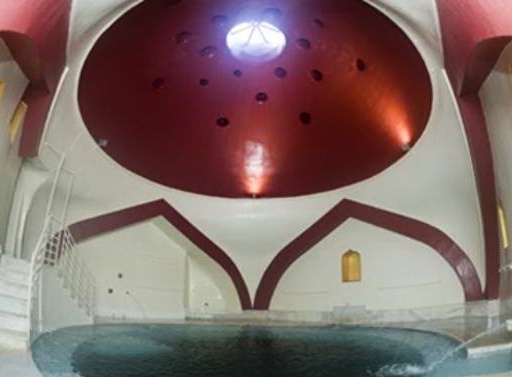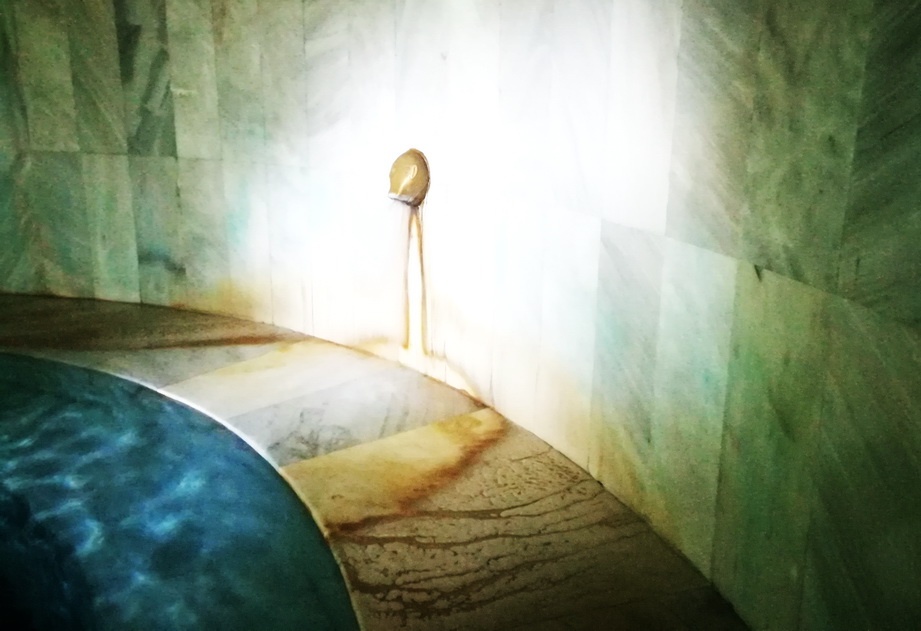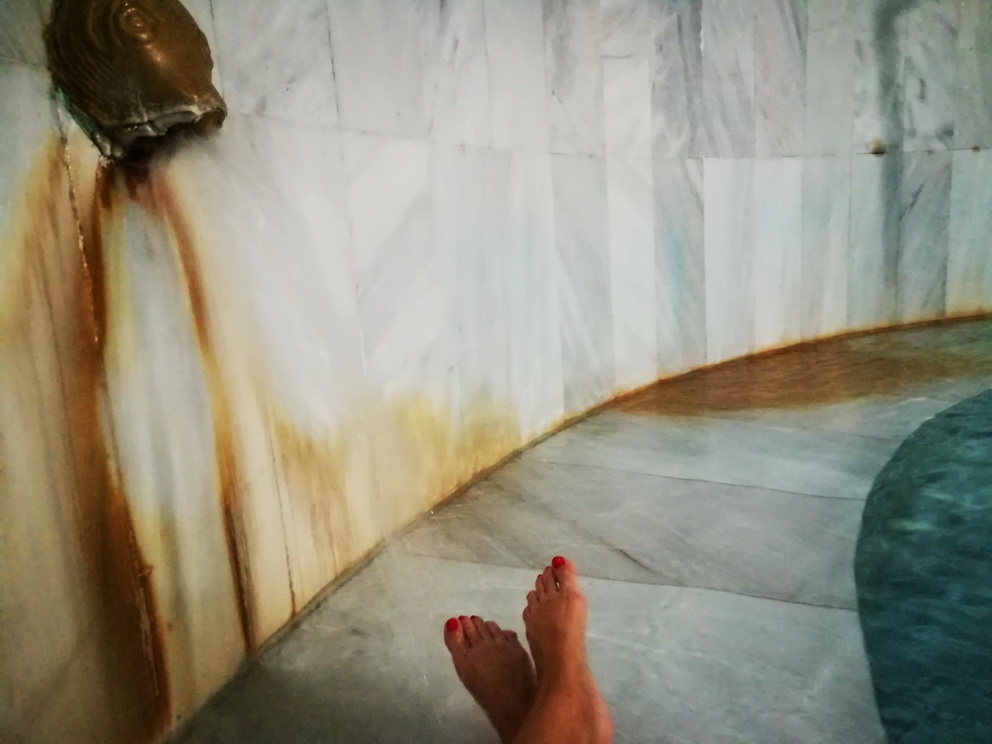Just outside of Thessaloniki, in the suburb of Lagada, there is a unique historic bathing experience. The Loutra Lagada – or Lagada Baths – have a history centuries’ long. Therapeutic waters have been flowing into these baths for over a millennium.
Thessaloniki has a history of bathing culture, but many of these historic baths are now closed, and serve as monuments. This is the only historic bath among the best spas in Thessaloniki.

The Baths of Lagada
Inside this clean but dull municipal facility is a fabulous surprise: there are two Byzantine era baths, beautifully intact. The Mygdonia bath is from 1400, and the Justinian is from a full 500 years earlier – 900 AD. Bathing here is not just therapeutic and enormously pleasurable; it’s a novel way to experience history. The baths have enjoyed centuries of uninterrupted use.
Visiting the Lagada Baths – Loutra Lagada is one of the best things to do in Thessaloniki – combining history, luxury, and health. It’s a great way to experience local culture.
Related post: Best Things to do in Thessaloniki – Sights, Activities, and Cultural Experiences
History and Legend of the Lagada Baths
The history of the baths starts long before their construction. The rich therapeutic spring that fills the baths was fabled centuries earlier. Legend has that Constantine the Great (272 AD – 337 AD) and his mother Helen (according to legend the discoverer of the true cross) bathed in these healing springs. Constantine the Great and his mother Helen are now Saints in the Orthodox church. The chapel at the baths is dedicated to Saints Constantine and Helen. Moreover, the town of Lagada celebrates these Saints on their feast day – May 21st – some with an astonishing ritual of fire walking.
The first pool of the Lagada baths – the Justinian Bath – dates from around 900. There are two explanations for its name: one gives credit to a military physician Justinian, another to a Roman general of the same name.
After the Ottomans conquered this region in 1430, under Murad II, they redid the Byzantine pools in the Ottoman style. The great domes over the baths have characteristic Ottoman brick arches, while the original Byzantine masonry is still in evidence. The baths, very much as we experience them today, appear in the famous 17th-century chronicler Evliya Çelebi’s Seyahatnâme: Book of Travels. Other visitors to baths include the Ottoman geographer M. Halzi-Salfa, who attested to the effectiveness of the waters in 1670, and the British traveler Martin William Leake, who came here in 1835.
Experiencing the Lagada Baths – Loutra Lagada

Each of the moderately-sized pools – comfortably holding perhaps a dozen bathers (maximum capacity 18) – has wooden planks on the floors which is very pleasant. Marble lines the baths and there is a high dome overhead, and plenty of natural light. The water is about chest high, and at 39° C (102° F), perfect for wallowing in and still just cool enough to paddle around in slowly. More therapeutic water cascades from fountains from the edges of the pool, making for a fine massage of the shoulders and neck.
There are also additional pools at the baths which are available for private groups by reservation. The Artemis and the Koroneia are modern pools.
There are also many private whirlpool baths with thermal therapeutic water available, also by reservation.
The Water Composition of the Lagada Baths
The warm waters of the Lagada springs are rich in beneficial minerals. They contain sodium (Na), calcium (Ca2), sulfate (SO4), bicarbonate (HCO3), potassium (K), and fluorine (F). This mineral composition renders it useful for a number of ailments. In additional to being beneficial for the joints and bones, the waters are useful for motor and rheumatic disorders, disorders of the circulatory and nervous systems, gynecological disorders, dysfunction of the liver and kidney, sensitivities of the gastrointestinal system, and skin diseases. The water is also suitable for drinking cures.
Even those who have no particular complaints will benefit from these healing waters. Its mild alkalinity makes it particularly soothing to the skin.
What to Bring to the Lagada Baths
The therapeutic waters of the Lagada Baths leave the skin silky soft. So you will not need any body lotion. Bathing suits however are required at the baths. You’ll also need a towel or two and a plastic bag for your wet bathing suit. A bathing cap is always advisable.
There are no lockers at the baths. You can leave valuables at the front desk.
Are the Lagada Baths Loutra Lagada Single-Sex or Mixed Gender?

The main pools at the Loutra Lagada – the Justinian and the Mygdonia – are single sex. They alternate between men and women on a daily basis. This applies from when the baths open until 19:30. After that time, the pools are available for private parties until the baths close.
Private groups of mixed or single gender can book the Koroneia (capacity 15) or Artemis (capacity 18) baths for a private session.
What Are the Hours of the Lagada Baths?
The Loutra Lagada are open every day from 8:00 – 22:00. The may close on some holidays. Consult their Facebook Page here.
How Much do the Lagada Baths Cost?
Not much! Individual entry to the Lagada Baths is €6. To reserve one of the Loutra Lagada pools – including the Justinian and Mygdonia (by evening) – call ahead. The price is €20 per group of four, and €4 for each additional person.
How do You Get to the Loutra Lagada?

The Lagada Baths are in the town of Lagada, a suburb of Thessaloniki. It’s easy to reach by public transportation. The bus line 83M leaves makes several departures a day, between one and two hours apart. You can board the bus 83M at the bus stop “Kamara” on Egnatia. This is about 40 meters before the triumphal arch, as the traffic flows. Many buses say 83 and they all go to Lagada, but only the 83M will take you to the Lagada Baths, which are just outside of town. You can also get the bus at other stops further along Egnatia. For schedule information, please see here.
The bus makes a loop. Therefore, in order to return to Thessaloniki, you get on one of the buses arriving from Thessaloniki. Calculate approximately 40 minutes from the departure time. The people at the desk can help you with the schedule. You may need to transfer buses at the terminal in Lagada. The bus drivers will guide you.
The Loutra Lagada are less than a half hour away from Thessaloniki by car, along the E79/E90 Thessaloniki – Kavala highway. Follow signs to Lagada, then turn right at the sign Lagada – Lagina. Turn left at the traffic lights and drive into the town. After that, turn right at the first traffic light in town. Continue on this street until the next lights. Finally, make another right and the road leads directly to the Loutra Lagada.
The Loutra Lagada – Lagada Baths
Especially if you’re visiting Thessaloniki in fall, winter, or spring, this makes a relaxing outing – like a beach day, but with more history. You won’t soon forget the experience, and your skin will not forget the therapeutic treat.
Have you been to a natural spa in Greece?

